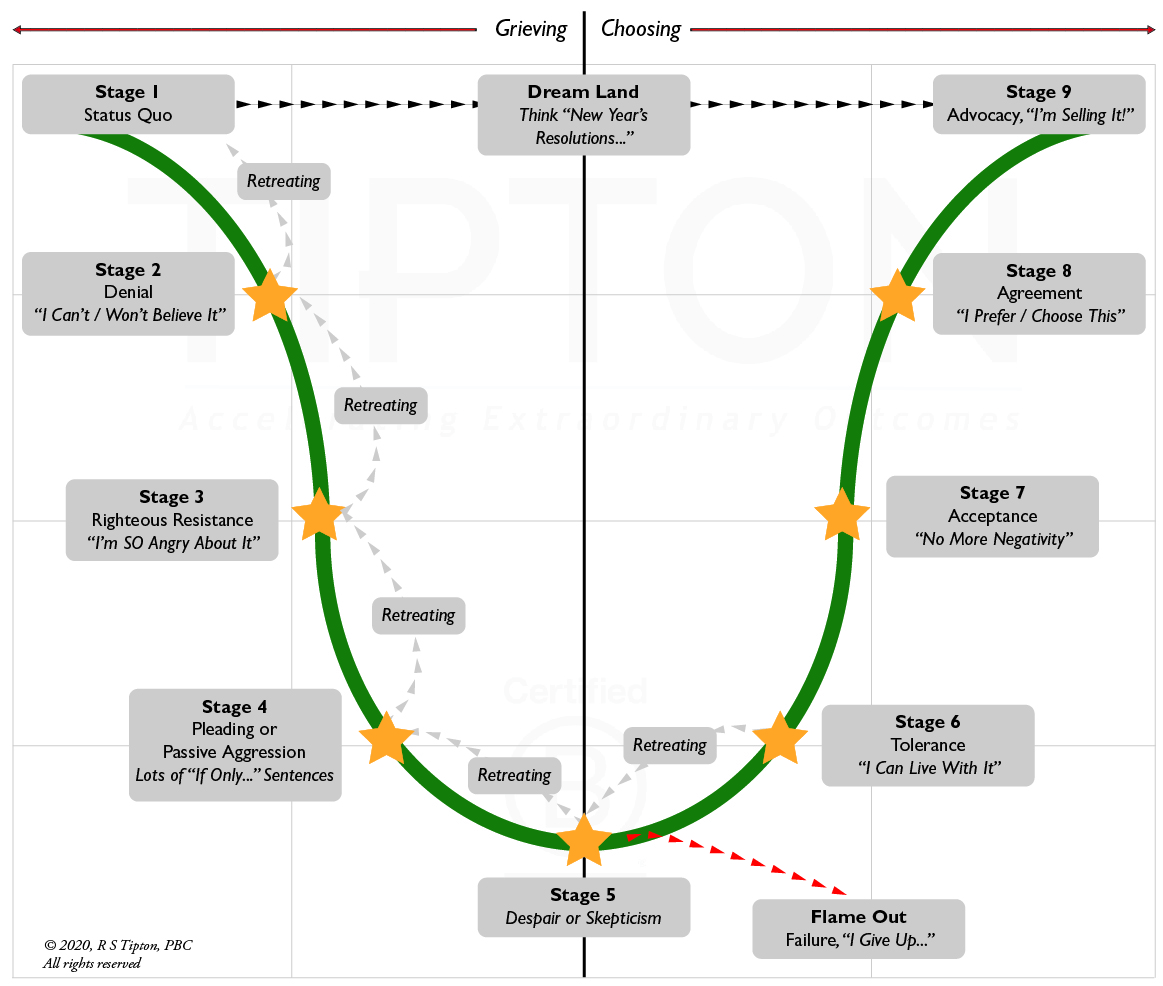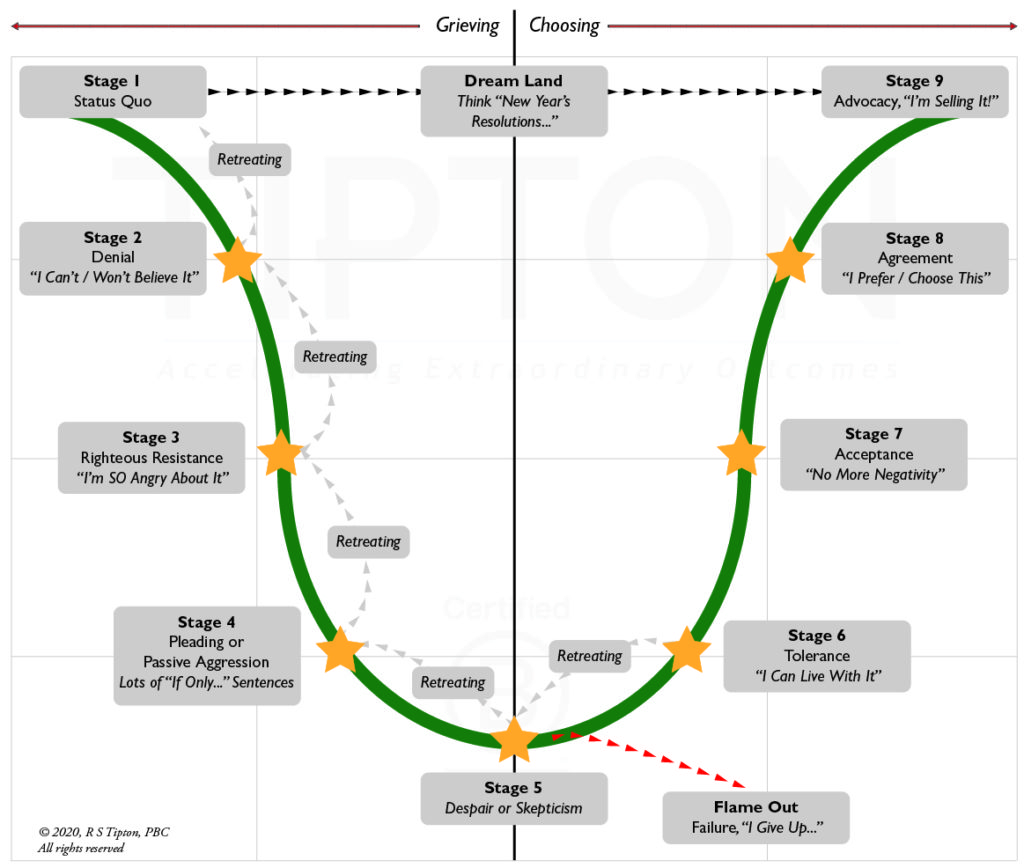
26 Mar “Instant Life Dislocations” – and Why Transformation Feels So Hard
Several years ago I published my “9 Stages of Transformational Change” curve (see below), and it’s become an extremely popular tool to explain why transformation almost always feels “hard” — especially in organizational life. (See previous BLOG POST and/or download my WHITE PAPER about it)
I thought I’d update it now, as the world is forced to deal with the COVID-19 pandemic — where “normal” is out the window, and for many people, the instant life dislocation (nothing is where it was, it seems) feels extremely hard.
Take a look at the image below and then read the descriptions of the nine stages. Clearly, the information I share represents generalizations that apply to “most of us.” Some of our situations right now are desperate, and I have deep empathy for those who find themselves feeling that way. That said, the 9 Stages of Transformational Change can apply to virtually any instant life dislocation (health, job, relationship, etc.) — not “just” the changes happening right now related to COVID-19. I hope you find it insightful and useful.
Authentic transformation starts with grief
Here’s the single most important insight about transformational change — and why it feels so hard: authentic transformation starts with grief.
In other words, as we head down the slope on the left side of the curve, we are entering the Elizabeth Kübler-Ross “grief and death” cycle. In fact, the more invested we are in the status quo (stage 1), and the more fearful we are about the change, the longer and deeper the left side of the curve will be.
When we’re faced with “instant life dislocations” — like the STAY AT HOME orders that are so prevalent in the world right now, our very foundations of life, the things we look at as normal and predictable are ripped away with little to no warning. We head down the curve in a heartbeat — entering into immediate grieving related to what we’ve lost about what life used to look like.
No question, for a few of us things like “stay at home orders” are no big deal — it’s just another blip on the radar of life. However, for the vast majority of us, instant life dislocations (like the order to stay at home) can be extremely disconcerting.
It’s a normal, predictable process for most of us
Consequently (for the majority of us), the 9 Stages of Transformational Change curve shows a normal, predictable process. For many people I share this with, just the fact that the whole thing can be represented as a process is comforting! They can plot themselves somewhere, and then they can see that there’s an eventual WAY OUT as well.
Throughout the process, while we may only visit a stage for a blink of an eye related to some changes, we might get stuck for days, weeks, months or years in other stages depending upon the “bigness” of the transformational change we’re asked to make.
My advice? Go through ALL the stages, but don’t get stuck too long in any of them.
Additionally, you can see the word retreating for many of the stages. All the way up until Stage 7 (acceptance), we can go backwards through the curve — revisiting stages we’ve already seen. This is also normal – and typical. However, once we reach Stage 7, we don’t slip backward — at least related to this transformational change!
Anyway, let’s take a look at the individual stages:
Dreamland (Stage 1 to Stage 9)
Okay — so this isn’t a stage by itself… Instead, it’s a way to attempt to avoid the “ickiness” of transformational change. It’s as if we could jump directly from stage 1 (status quo) to stage 9 (advocacy) by magic. However, that rarely happens. If we just “close our eyes and hold our nose” and try to jump over the transformational change curve, we’re likely going to visit the curve later — and it’ll be worse when we do.
Therefore, I call it “Dreamland.” An example of a dreamland jump? A politician telling us that “everything will be okay, and just get back to living your life” — when the facts are telling a very different story.
Stage 1: Status Quo
Status Quo is simply what “is” at the beginning of the transformational change process. It is the known, the predictable, the safe, etc. And then — boom! Someone or something initiates a change, and we start “down” the transformational change curve. Imagine life before the “stay at home order…”
Next stop? Denial (and no, that’s not a river in Egypt!).
Stage 2: Denial
Denial is our first response to an instant life dislocation (and again, this is exactly like Elizabeth Kübler-Ross’ grief and death cycle). This is when we find ourselves saying things like, “I can’t believe it.” For some, denial can be quick — while for others they can stay in denial for a LONG time — like forever.
I recall a moment with someone close to me when she discovered that the public schools in our city were going to be closed for a least a month due to COVID-19. Her reaction? “That can’t be true. How can that be possible? How will I manage my life with my kids home all day?” Alas, it was true.
It also amazes me the number of individuals who just decided that the virus wasn’t going to affect them. So they said, “let’s do what we’ve always done — like go to the beach en masse for Spring Break!” Now, many of those individuals are infected.
Stage 3: Righteous Resistance
The next stop along the transformational change curve is “righteous resistance” — or anger, or pissed-off-ness. I’d be willing to bet that you’re currently in the anger stage, or have recently left it related to the government TELLING you that you have to stay home, or close your business, or change the way you live in any way.
Again, the person close to me (see above) and their movement to anger? It was clear… “Who thought THIS was a good idea? Great! Those politicians can come and watch my kids for me… Seriously! WHAT. AM. I. GOING. TO. DO?” And — this person was totally justified in feeling angry about the situation.
Anger? Normal, important — but temporary. The longer we stay angry about an instant life dislocation, the longer we delay our ability to “keep moving” through the transformational change curve. Get angry! Yes! But, move on.
Stage 4: Pleading
After anger comes pleading, or bargaining, or wishful thinking… Listen for sentences starting with the words, “If only…” and you’ll know you’re in the presence of pleading.
“If only those idiot politicians would pull their heads out…” “If only the initial outbreak of the virus was managed better…” “If only I could know exactly when life would be ‘back to normal’…” And so on.
Each time we say, “If only” we are living in a time that isn’t “now,” and we are denying what actually IS. Yes, bargaining is another normal step along the way — but it’s also temporary. Rather than saying, “If only,” say “now that things are different, I need to do this instead of what I used to do before.” It changes your viewpoint immediately.
Stage 5: Despair / Skepticism
This is where things truly feel icky; our energy is low, our attitudes suck, and our general outlook about things is bleak. And — again, it’s a temporary stage along the way. As the old saying goes, “All things pass…” — this applies to stage 5. It isn’t permanent — unless you CHOOSE to make it so.
Stage 5 is the point where we actively CHOOSE what we prefer:
-
-
- We can stay at Stage 5, become an energy vampire (sucking it out of everyone around us), and live in despair or skepticism.
- We can go backwards to “pleading” because maybe we feel better being there.
- We can “Flame Out” — and give up. For situations like the COVID-19 “stay at home” order, I guess we could simply pack up our car, drive away, and try to find a way to live off the grid. I believe some are trying that, and for them it’s a good choice.
- We can choose to move forward — to GROW, to CHOOSE the change that we’re part of.
-
Stage 5 is the turning point. We need to get here as quickly as we can — so that we can move forward. If you haven’t yet visited Stage 5, you will. When you get there — make a choice to move forward, and you’ll get beyond Stage 5 more quickly as well.
Stage 6: Tolerance
Okay — so if you find yourself here, it means you’ve made it “through the knothole” of Stage 5, and you’ve decided to move forward THROUGH the transformation. That said — at Stage 6 — it’s also clear you haven’t yet come to complete agreement with the transformation (brought about by an instant life dislocation like COVID-19, or something else).
In other words, you say yes when someone asks you this question, “Can you live with it?” Can you “live with” the stay at home order? “Okay, sure — I can live with it. I’m not happy about it, but I’ll get by.” Move on.
That’s tolerance to me — it’s possible to still harbor some negativity and move forward at the same time. Don’t wait until you feel 100% comfortable — have the courage to “live with it” even if you still have some negativity, and you can start the process of moving ahead.
Stage 7: Acceptance
There’s something different about the chart at Stage 7 — there’s no more retreating at this point. Why? Because at acceptance we are at least neutral about the change — our negativity has been resolved.
We have made the choice to “take down” the rearview mirror completely and to move forward harboring no negative thoughts. This is a HUGE step in the transformational change process — and the sooner we can reach this stage, the better.
In my experience right now, younger kids are giving many of us life lessons related to how to act in Stage 7. They have simply moved on, and are embracing life “as it is” right now — they’re singing, dancing, painting, coloring, etc. Maybe we could learn something from them! Getting to acceptance is healthy — it represents our ability to adapt to our new reality, and to find the joy, beauty, and benefits in it — as it is, not as we “wish” it would be.
Stage 8: Agreement
Stage 8 represents “agreement” — where we’re beyond neutrality — we’re actively positive. It’s OUR CHOICE to feel and believe this way, and our behavior reflects it. We are openly optimistic, we share our hope for a positive outcome, and we anticipate the benefits coming from the change process.
I have no idea what life “after COVID-19” looks like for sure, but I know simply returning to everything exactly as it was before the pandemic isn’t likely to be true. That said, I believe it’s important to embrace (not simply accept) the situation as it is now — follow the rules, be kind to ourselves and others, keep our sense of humor, be generous, seek the joy in where we are — rather than live in a way where we are longing for what was (ruminating) or worrying about what might be.
Yes — we need to plan, to be prepared, to take care of ourselves, and make good decisions. But — we can do that from a place of optimism and positive forward momentum. Be prepared to thrive in the NEW normal — that what Stage 8 is all about.
Stage 9: Advocacy
Getting to the advocacy stage is the holy grail of transformational change leadership. Why? Because at this stage people are so positive that they become advocates for the transformation itself. They have CHOSEN to become passionate advocates for the change — there’s no buy-in, no convincing, no arm twisting, no “or-else” statements.
Advocates are high-energy, positive agents related to the transformation and it’s WONDERFUL to be in their presence. I’d be willing to bet you know someone who is FULLY embracing and embodying optimism, hope, joy, and a belief in a positive future — post COVID-19. At times you may feel they are being naive, or aren’t living in the “real world.” However, maybe consider that their view of the real world IS what they are showing.
The Life Lesson
So… There you have it. The “9 Stages of Transformational Change” — from the Status Quo to Advocacy in all of its glory. And — there’s a transformational change life lesson (or two) available here as well.
First — remember, authentic transformation (regardless of whether it’s triggered by an instant life dislocation or not) starts with grieving. Give yourself space and grace to FEEL what you are feeling — and remember that you’re moving through a predictable process that has an end point. Be KIND to yourself.
Second — be aware that everyone experiences transformation uniquely. While you and your family are all asked to stay home right now, each person will be in different places on the transformational change curve, about different things, at different times. Give those around you space and grace as well as they are processing their instant life dislocation. Be KIND to those around you.
Hopefully, the 9 Stages of Transformational Change is a helpful tool — not only so that you have the chance to “name” how you’re feeling right now, but also as a way to see a path forward. We can do this!




No Comments